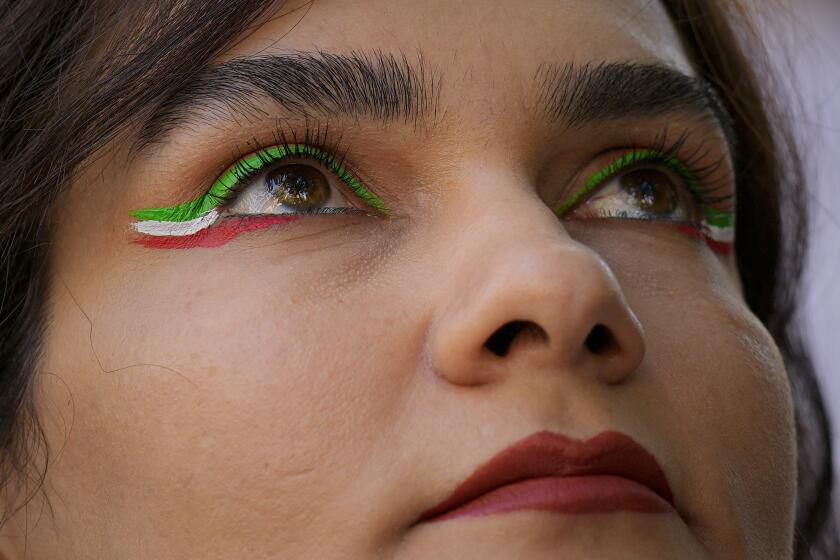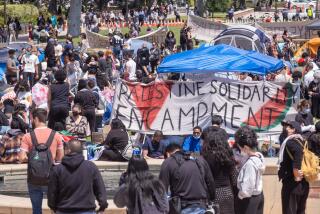Iranian women at home and abroad cut their hair to protest Mahsa Amini’s death
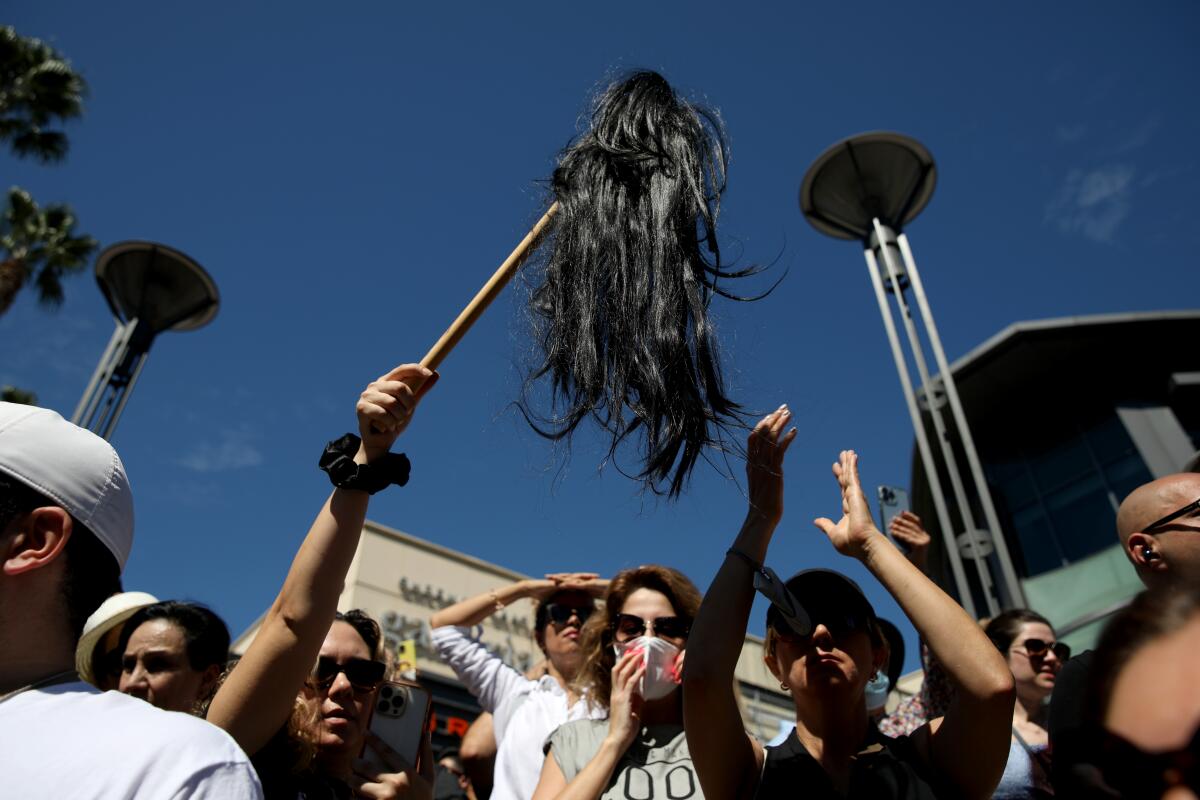
Standing before her bathroom mirror, Elnaz Rahimpour fluffed her curly hair before braiding the tendrils into four pieces.
The killing of Mahsa Amini in Iran have set off worldwide protests by the country’s large diaspora. We hear their stories.
She reached for the scissors and cut each dark lock with tears in her eyes, as an old Iranian resistance anthem streamed over the video she posted to Instagram — her own gesture of protest in solidarity with the movement that has coursed through Iran in the weeks since a 22-year-old woman, Mahsa Amini, died at a Tehran hospital after reportedly being brutalized by the country’s morality police.
Amid protests across Iran, many women in the country have adopted the political symbolism of cutting their hair — at once a statement against oppression and the rules of compulsory hijab for women, and an act of defiance in honor of Amini, who was arrested for allegedly violating the Islamic Republic’s modesty laws.

“So many others of my friends are still there dealing with this,” said Rahimpour, 29, a student at Marshall University in West Virginia. “I wanted to show how horrible it is to kill someone because of something as simple as hair.... Only because of her hair, Mahsa died. To me, it just felt like the right thing to do.”
The protests that erupted across Iran on Sept. 16 have been led by women encompassing broad cross-sections of Iranian society — and quickly tapped into wider discontent over women’s rights and government corruption. The Norway-based nonprofit Iran Human Rights estimates that at least 154 people have been killed during the protests. Hundreds more have been arrested in violent crackdowns.
Videos of protests in Iran show women — most of them young — waving their hijabs in the air, some of them throwing their head scarves into bonfires; others defiantly leave their hair uncovered as they pour into crowds that chant “zan, zendegi, azadi” — “woman, life, freedom,” a rallying cry of the movement — or call for “Death to the dictator!”
Young schoolgirls and high school students have also grown into a force in the movement. Videos posted on Twitter showed students heckling a paramilitary officer while taking off their head scarves, and several images shared across social media appear to show girls at school protesting in front of classroom chalkboards with their hair flowing down their backs.
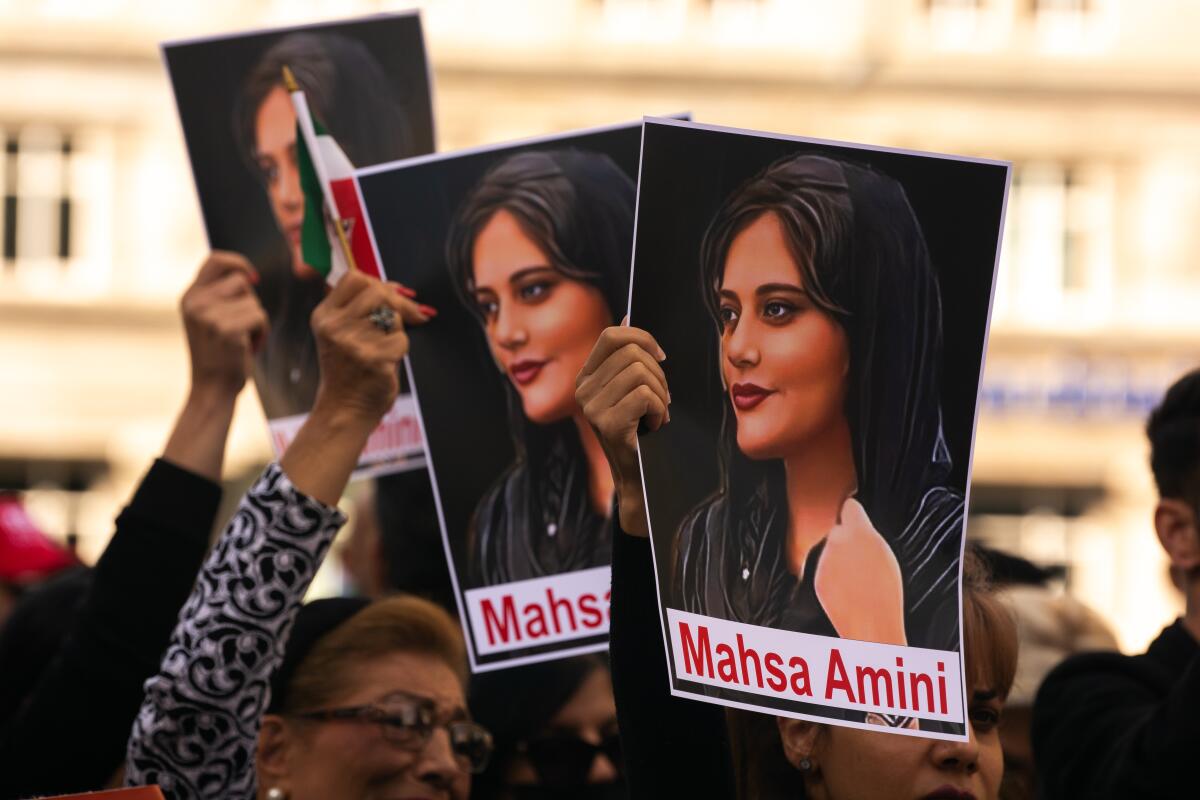
Yet it is the symbolism of hair-cutting that has persisted not only in Iran, but also around the world.
Videos circulating on TikTok, Twitter and Instagram show a woman cutting her hair over her brother’s coffin during his funeral, slamming her locks on top of the flowers that cover his casket. Video captions assert that her brother was killed while protesting.
A photo circulating on Twitter and Instagram appeared to show a young woman, her head shaved, standing beside her mother’s grave while holding the hair she’d cut in her hand.
In Los Angeles, an Iranian American protester sat on the steps to City Hall and snipped her hair, crying out, “For Iran!” In Istanbul, media coverage showed an Iranian woman cutting off her ponytail during a demonstration outside the Iranian Consulate.
To some, the practice evokes rituals described in ancient Persian poetry and literature in which women cut their hair in mourning or protest. In “Shahnameh: The Persian Book of Kings,” the poet Ferdowsi refers to the hero Siavash’s wife cutting “her musky tresses” and binding them to her waist to protest his death. For others, it is a demonstration of power that shows that women cannot be controlled by the hair on their head.
Scholars following the current protests in Iran say that the movement is distinct because it has unified Iranians across socioeconomic lines, geographic regions, ethnicity and gender under the banner of women’s rights and the need for systemic governmental change.
“It’s about compulsory hijab, it’s about the subjugation of women’s bodies by the state, by the Islamic Republic. There are slogans against the oppression of the Islamic Republic, so this brings together all the previous protests against autocracy and despotism in Iran,” said Mohammad Ali Kadivar, an assistant professor of sociology and international studies at Boston College.
“This protest started with the death of a Sunni, Kurdish woman, which brings together again the intersection of women’s issues, and also ethnic minorities,” he added, referring to the Shiite Muslim-majority population of Iran.
The protests are also global, he said, noting this month’s demonstrations in solidarity with Iran that spanned roughly 150 cities, from Los Angeles to London.
The protests differ from Iran’s 2009 Green Movement, during which many Iranians disputed a presidential election they argued was fraudulent, Kadivar said. Those protests prompted a violent crackdown in which dozens were killed and thousands arrested. Authorities tortured prisoners and held Stalin-style show trials in which defendants were forced to confess they were foreign agents.
“The discourse of that movement was a reformist discourse, it was not calling for a full break from the framework of the Islamic Republic,” he said. “Women were present in 2009.... Women’s issues were I think articulated in 2009. But they didn’t have the leading role that they have now.”
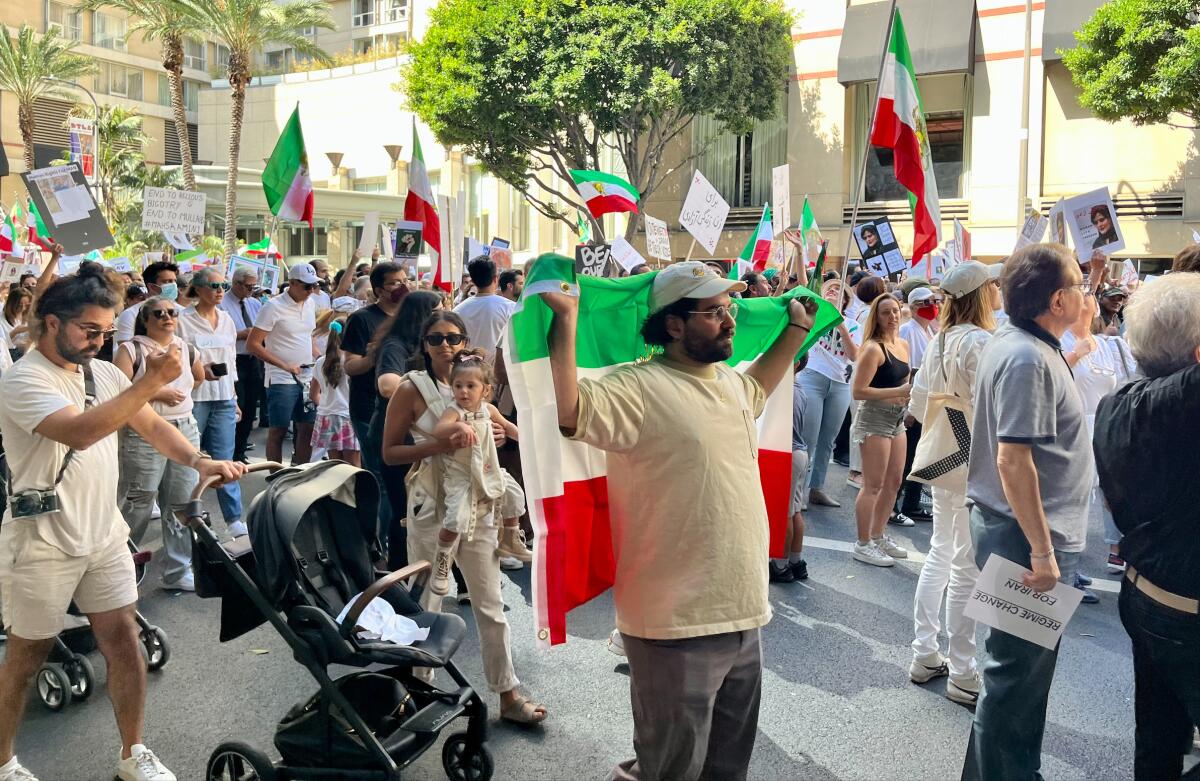
Watching Iranian women rallying in the streets inspired Nicole Ansari to post an Instagram video of herself cutting her hair. She watched as her counterparts in Iran reached for the scissors and felt that she also needed to take action.
“I thought, what am I doing here? You know, here I am so privileged. What can I do to amplify the voices other than just reposting things that are happening there?” said Ansari, an actor and director who lives in New York. “I read in one of the posts the significance of cutting your hair and how it’s a sign of mourning, and it comes from an ancient Persian tradition before Islam. And I thought, let me at least do that.”
As she snipped away the highlighted light brown hair hanging at her neck, she felt “liberated.” Like many in the diaspora, she believes this protest differs from previous movements even if she doesn’t know what the outcome will be.
Ansari, who hasn’t visited Iran since she was a child — during the shah’s reign before the 1978-79 revolution — said that watching the protests from afar has been “an emotional roller coaster.”
“I am in mourning for those women who have given their lives, those people who give their lives for freedom of expression, freedom of speech, freedom of choice to wear the head scarf or not,” she said.
It’s not just women who are cutting their hair. Both in Iran and abroad, men are also shaving their heads in solidarity and standing beside women as they call for equality and freedom. That kind of support sets this round of protests apart from other movements in Iran, said Abbas Milani, director of Iranian studies at Stanford University.

“More and more, men are saying, yes, if we really want democracy in Iran, we have to fix this problem. Women’s rights are the most important measure of democracy everywhere,” Milani said. “And men have finally, I think, in the largest ever numbers, recognized that if they don’t fight for women and for their equality, you’re never going to have a democracy.”
Arash Mofakham, who moved to California from Iran to pursue his master’s degree, felt that shaving his head and posting about it online was the best way to raise awareness about the protests — even if doing so was outside his comfort zone.
“It actually worked well, because a lot of people started reading about the news in Iran after they saw the video that I posted,” said Mofakham, who was born and raised in Tehran. “They came to me and they gave sympathy and they just shared their feelings about what’s going on. And they hugged me. I thought, this is kind of like what I was looking for.”
The 36-year-old said he lived in Iran in 2009 and regularly protested during the Green Movement. The images he sees online today remind him of his experience 13 years ago.
“Even though it’s a different purpose right now, it’s a different generation, I think we all fight for the same reason at the end of the day,” he said. “We want to have the freedom of speech, rights and basically reform and change the regime.”
Protesters in Iran are looking for substantive regime change, he added, not reforms to the current government.
Although the protest movement hasn’t yet united around a specific leader, Mofakham said, people have concluded that the current system doesn’t work.
“After 40 years, there is no correction,” he said. “There is no reformists. We still have have the same issues — basic, basic issues — that they cannot solve, which means they are not capable.”
For Rahimpour, who lived in Shiraz with her family from the age of 6 to 16, the act of cutting her hair felt deeply personal because of her upbringing in Iran. She remembers the panic that would rush through her if a gust of wind pulled her head scarf down, and quickly having to adjust the fabric — a byproduct of “this fear that’s [instilled] in you from such a young age.”
“I don’t want any other generation growing up in this fear of not being able to live a basic life,” she said.
When she was 12, she was taken into custody by Iran’s morality police on her way home from school. She had pushed up her sleeves enough to reveal part of her wrists, she said, and a few wisps of her hair fell out of her head scarf.
“I was just quietly walking home. And I remember three women in all black clothing in their chadors,” Rahimpour recalled. “They’re like, ‘We need to talk to you real quick.’ I said no. I just broke down crying in that moment.”
She was driven downtown and pushed into a dark room. Several hours later, a woman lectured her after telling her that her parents were outside.
“She was just telling me how much I’ve sinned and she read some Quran for me,” Rahimpour said. “This lady was educating me on how wrong I am and how I’m gonna go to hell.... She made me pull out a string of hair. She said, ‘If that hurts, imagine getting hanged by your hair for all eternity.’ And I just I didn’t know what to say.”
Her detention by the morality police still haunts her, she said. Even living in the U.S., she’s afraid of public displays of affection with a partner. She feels afraid to hold hands in public, despite knowing that she wouldn’t be punished.
“When this happened, I just couldn’t stop thinking about what happened to me,” she said of Amini’s death. “I could have died in that scenario. I could have been kept overnight if my parents hadn’t gotten me out that night. And maybe this would have been me.”
More to Read
Sign up for Essential California
The most important California stories and recommendations in your inbox every morning.
You may occasionally receive promotional content from the Los Angeles Times.
